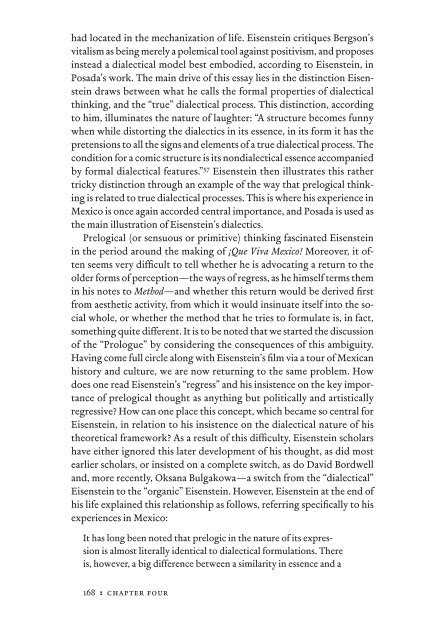In Excess: Sergei Eisentein's Mexico - Cineclub
In Excess: Sergei Eisentein's Mexico - Cineclub
In Excess: Sergei Eisentein's Mexico - Cineclub
You also want an ePaper? Increase the reach of your titles
YUMPU automatically turns print PDFs into web optimized ePapers that Google loves.
had located in the mechanization of life. Eisenstein critiques Bergson’s<br />
vitalism as being merely a polemical tool against positivism, and proposes<br />
instead a dialectical model best embodied, according to Eisenstein, in<br />
Posada’s work. The main drive of this essay lies in the distinction Eisenstein<br />
draws between what he calls the formal properties of dialectical<br />
thinking, and the “true” dialectical process. This distinction, according<br />
to him, illuminates the nature of laughter: “A structure becomes funny<br />
when while distorting the dialectics in its essence, in its form it has the<br />
pretensions to all the signs and elements of a true dialectical process. The<br />
condition for a comic structure is its nondialectical essence accompanied<br />
by formal dialectical features.” 57 Eisenstein then illustrates this rather<br />
tricky distinction through an example of the way that prelogical thinking<br />
is related to true dialectical processes. This is where his experience in<br />
<strong>Mexico</strong> is once again accorded central importance, and Posada is used as<br />
the main illustration of Eisenstein’s dialectics.<br />
Prelogical (or sensuous or primitive) thinking fascinated Eisenstein<br />
in the period around the making of ¡Que Viva <strong>Mexico</strong>! Moreover, it often<br />
seems very diffi cult to tell whether he is advocating a return to the<br />
older forms of perception—the ways of regress, as he himself terms them<br />
in his notes to Method—and whether this return would be derived fi rst<br />
from aesthetic activity, from which it would insinuate itself into the social<br />
whole, or whether the method that he tries to formulate is, in fact,<br />
something quite different. It is to be noted that we started the discussion<br />
of the “Prologue” by considering the consequences of this ambiguity.<br />
Having come full circle along with Eisenstein’s fi lm via a tour of Mexican<br />
history and culture, we are now returning to the same problem. How<br />
does one read Eisenstein’s “regress” and his insistence on the key importance<br />
of prelogical thought as anything but politically and artistically<br />
regressive? How can one place this concept, which became so central for<br />
Eisenstein, in relation to his insistence on the dialectical nature of his<br />
theoretical framework? As a result of this diffi culty, Eisenstein scholars<br />
have either ignored this later development of his thought, as did most<br />
earlier scholars, or insisted on a complete switch, as do David Bordwell<br />
and, more recently, Oksana Bulgakowa—a switch from the “dialectical”<br />
Eisenstein to the “organic” Eisenstein. However, Eisenstein at the end of<br />
his life explained this relationship as follows, referring specifi cally to his<br />
experiences in <strong>Mexico</strong>:<br />
It has long been noted that prelogic in the nature of its expression<br />
is almost literally identical to dialectical formulations. There<br />
is, however, a big difference between a similarity in essence and a<br />
168 : chapter four


